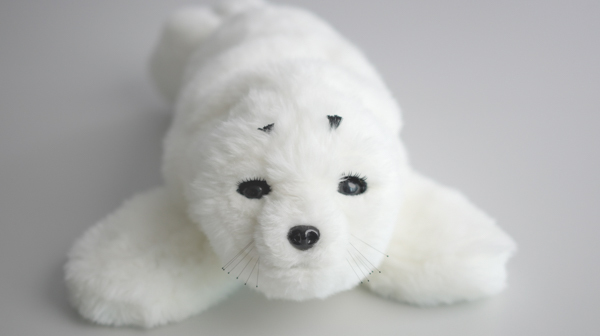
The University of Guelph-Humber’s Early Childhood Studies program has a new, leading-edge learning tool that also happens to have fluffy fur, coo like a baby seal, and love being hugged. Meet Paro, an advanced therapeutic robot that is not only cute and cuddly, but is also having a serious impact on mental health therapy for patients at all stages of life.
Developed by a leading Japanese industrial automation pioneer, Paro is a technologically advanced interactive robot that offers many of the same benefits of animal therapy to patients who are in environments where interacting with live animals isn’t practical or possible.
Designed to behave like a real pet, Paro has been found to reduce stress in patients and their caregivers, and it’s been used in hospitals, long-term care facilities, retirement communities, and children’s rehabilitation centres all over the world.
For students in UofGH’s Early Childhood Studies program, Paro will be both another valuable resource that they can bring into real-world professional settings — including early-learning environments and hospitals — as well as an important resource that can inspire academic conversations about the ways in which kids engage with technology.
“I hope that Paro is going to show our students the lovely connection that can happen between children and technology,” said Early Childhood Studies Program Head Dr. Nikki Martyn. “How can we create opportunities for children to engage with technology in healthy, meaningful ways, without concerns around ethics, privacy, or creating habits that aren’t really in a child’s best interests?
“Paro was designed for social, emotional, and mental health wellbeing, so I’m hoping that Paro will be used in our classrooms to talk about what it feels like and means to connect — because connection is so important,” Dr. Martyn added.
“Paro will provide another way to help and support children — or students and adults — when they need that connection, a snuggle, or a hug.”
Paro brings the well-documented features and benefits of animal therapy into environments where you can’t bring animals, and it allows children to feel connected and safe.

An adorable A.I. companion
Outfitted with five different kinds of sensors for touch, light, audition, temperature, and posture, Paro can actually sense people and respond to their touch or voices. When someone pets or hugs Paro, it responds as if it is a real, live baby harp seal, “talking” back and wriggling its head and legs.
Paro is also responsive, meaning that it can even learn and adapt its behaviour to different people and the ways they prefer to interact with it.
“Paro brings the well-documented features and benefits of animal therapy into environments where you can’t bring animals, and it allows children to feel connected and safe,” Dr. Martyn explained.
“Unlike a regular stuffed animal, it has an interactive component to it. Paro looks up at you with its big eyes and you kind of melt.”
Paro will be housed at the University of Guelph Humber’s Resource Room, which features an extensive collection of educational and therapeutic toys, books, and other learning materials that Early Childhood Studies students can borrow and bring to their field placements.
Given that UofGH’s ECS students commonly complete practicums in settings including children’s mental health centres, community-based family organizations, hospital child life units, and inclusive early learning and care centres, Paro will certainly prove to be a valuable tool for students both practically and academically.
“Paro will be there for students to play and snuggle with when they need it, but also — as with all of our resources — students will be able to take Paro and engage with it in the real world with real children,” Dr. Martyn said.
“When they bring Paro into hospitals, early-learning centres, and other settings where our students do child-life practicums, we will be able to discuss things like: How do we care for Paro? How do we touch it nicely? And within the classroom, Paro gives our students a full understanding of the importance of children learning to self-regulate and self-soothe.
“This will all build skills around empathy, compassion, and care. Sometimes when you have a robot like Paro that can speak to your heart, you don’t use your brain so much — you remember what it is to be human and to love and connect.”
Innovation in early childhood education
Paro is just one example of the ways that the Early Childhood Studies program at the University of Guelph-Humber integrates innovative technology into its academic approach.
In addition to the recent purchase of five Oculus Rift VR headsets for students to use, the ECS program also uses UofGH’s technologically enhanced Learning Lab in creative ways to encourage students to think about how to effectively use technology to enhance a child’s educational experience.
“This is the University of Guelph-Humber — we learn by doing. And it’s really important that educators and people working with children understand technology and have the opportunity to experience what the new technologies are that children might engage with — because this is the world that children are going to be living in,” Dr. Martyn explained.
“In ECS, it’s important that we understand how technology affects children and impacts their lives so that we can make it safe for children. I bring this technology into our environment at the University of Guelph-Humber so that our students can learn and grow with it, and ultimately think critically about how these constantly changing technologies will be used in the lives of children.
“For me, that is our responsibility as experts in early childhood.”

